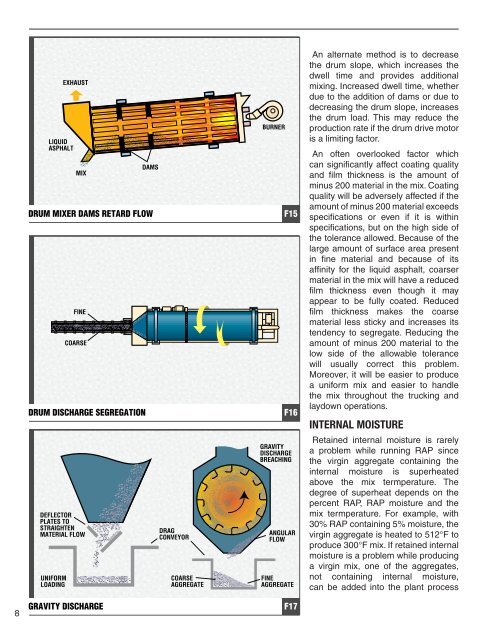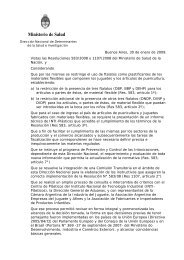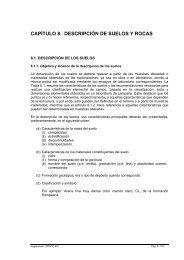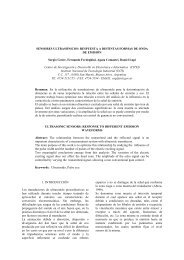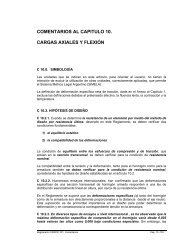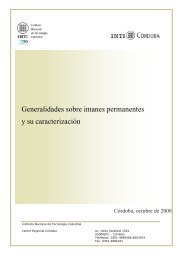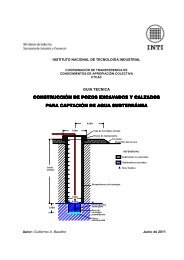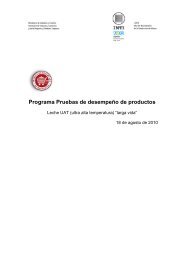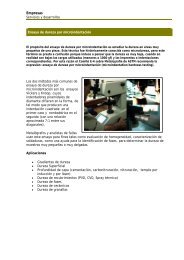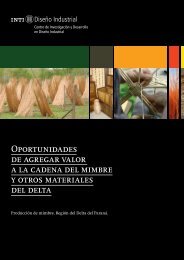SEGREGATION: Causes and Cures - INTI
SEGREGATION: Causes and Cures - INTI
SEGREGATION: Causes and Cures - INTI
Create successful ePaper yourself
Turn your PDF publications into a flip-book with our unique Google optimized e-Paper software.
8<br />
LIQUID<br />
ASPHALT<br />
EXHAUST<br />
MIX<br />
DRUM MIXER DAMS RETARD FLOW F15<br />
FINE<br />
COARSE<br />
DAMS<br />
BURNER<br />
DRUM DISCHARGE <strong>SEGREGATION</strong> F16<br />
DEFLECTOR<br />
PLATES TO<br />
STRAIGHTEN<br />
MATERIAL FLOW<br />
UNIFORM<br />
LOADING<br />
DRAG<br />
CONVEYOR<br />
COARSE<br />
AGGREGATE<br />
GRAVITY<br />
DISCHARGE<br />
BREACHING<br />
ANGULAR<br />
FLOW<br />
FINE<br />
AGGREGATE<br />
GRAVITY DISCHARGE F17<br />
An alternate method is to decrease<br />
the drum slope, which increases the<br />
dwell time <strong>and</strong> provides additional<br />
mixing. Increased dwell time, whether<br />
due to the addition of dams or due to<br />
decreasing the drum slope, increases<br />
the drum load. This may reduce the<br />
production rate if the drum drive motor<br />
is a limiting factor.<br />
An often overlooked factor which<br />
can signifi cantly affect coating quality<br />
<strong>and</strong> fi lm thickness is the amount of<br />
minus 200 material in the mix. Coating<br />
quality will be adversely affected if the<br />
amount of minus 200 material exceeds<br />
specifi cations or even if it is within<br />
specifi cations, but on the high side of<br />
the tolerance allowed. Because of the<br />
large amount of surface area present<br />
in fi ne material <strong>and</strong> because of its<br />
affi nity for the liquid asphalt, coarser<br />
material in the mix will have a reduced<br />
fi lm thickness even though it may<br />
appear to be fully coated. Reduced<br />
fi lm thickness makes the coarse<br />
material less sticky <strong>and</strong> increases its<br />
tendency to segregate. Reducing the<br />
amount of minus 200 material to the<br />
low side of the allowable tolerance<br />
will usually correct this problem.<br />
Moreover, it will be easier to produce<br />
a uniform mix <strong>and</strong> easier to h<strong>and</strong>le<br />
the mix throughout the trucking <strong>and</strong><br />
laydown operations.<br />
INTERNAL MOISTURE<br />
Retained internal moisture is rarely<br />
a problem while running RAP since<br />
the virgin aggregate containing the<br />
internal moisture is superheated<br />
above the mix termperature. The<br />
degree of superheat depends on the<br />
percent RAP, RAP moisture <strong>and</strong> the<br />
mix termperature. For example, with<br />
30% RAP containing 5% moisture, the<br />
virgin aggregate is heated to 512°F to<br />
produce 300°F mix. If retained internal<br />
moisture is a problem while producing<br />
a virgin mix, one of the aggregates,<br />
not containing internal moisture,<br />
can be added into the plant process


